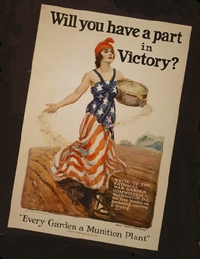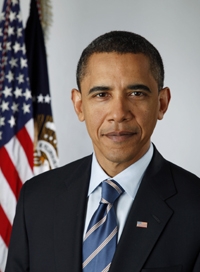Posts Tagged: Victory Gardens
Summon us to service
For more than a hundred years, gardening has been linked to service in American communities. Reformers used school and community gardens to improve aspects of urban life, to educate children, to feed the hungry, to provide training to those facing economic challenges. Today, the University of California models service through gardening via its Master Gardener Program, which fields thousands of highly trained gardens who provide support for school, home and community gardens across the state.
Our nation has many needs right now. Families are economically insecure. (This is an understatement). Communities are food-insecure. Obesity is epidemic; the figures on childhood obesity are particularly disturbing. We have a tenuous connection with the land and a poor understanding of our food system. Environmental concerns - and declining oil supplies - dictate a need to recreate more sustainable and local food systems. Despite the bad news, Americans have proven that they are hungry for change, eager to re-engage with their neighbors, their communities and their nation.
A revival of the successful national gardening programs (Victory Gardens) of the past is clearly occurring. Gardening and the local food movement are hot topics. And consider the USDA’s Peoples Garden Initiative (PGI), which was launched in 2009, on the biennial of Abraham Lincoln's birthday. (This was fitting: President Lincoln created the USDA and felt strongly that Americans needed to know how to cultivate land - even small parcels - to keep freedom secure).
The PGI is making good progress across the nation: there are now Peoples Gardens in every state. If encouraged and supported by us, the PGI could help in myriad ways. The infrastructure for the program is already in place. The educational materials that support school, home and community gardens are available through existing government agencies and private organizations. And, as I suggested to Agricultural Secretary Tom Vilsack via the Huffington Post, thousands of highly-trained volunteer Master Gardeners (who serve under the USDA’s umbrella, through land grant institutions) can be called upon to share their expertise with school, home and community gardeners.
I’ve said it before, and I’ll say it again: all President Obama needs to do is ask. Help us once again engage Americans in service to nation through gardening. Summon us to service. Come out to your garden, admit to us that that we’re experiencing rough times, but tell us that we can make a difference by acting locally - through the simple act of gardening. Encourage those who can to plant a garden to do it. Summon us to service: Ask us to plant for our families and our communities, to grow a row for the hungry, to share any extra produce with food banks.
Mr. President, we’re hungry for change (and a shameful number of Americans are just plain hungry). Sometimes to move forward, we must look back for inspiration. Certainly, the Victory Gardens of the past provide a wonderful example of what ordinary citizens can accomplish on the home front to respond to challenges in the larger world. The revival of a national Victory Garden campaign can provide the kind of change we can dig into, some good news we can all use right now.
I can’t miraculously create millions of jobs, or clean up the oil currently in the Gulf, but I can facilitate the small miracle of growing and providing fresh produce to my family, and perhaps sharing it with those who are experiencing hunger in my community. Please, Mr. President: Summon us to service.
Victory Gardens: Join the garden revolution
Rose Hayden-Smith, Ventura County Cooperative Extension director and U.S. historian is passionate about the power and possibilities inherent in gardening. She uses her extensive knowledge of homefront war efforts to help influence public policy in regards to local food systems.
Earlier this year Dr. Hayden-Smith gave a lecture, Victory Gardens: Join the Garden Revolution, at the San Diego Natural History Museum about this topic.
More about the lecture.
At no point in our lifetimes has the interest in gardening, urban agriculture, and local food systems been so intense. It’s coming from all fronts—economic need, challenges presented by climate change, community-development needs, health and nutrition, food security, reconnecting youth with land, changing understandings of how we use space in urban areas, and a growing desire of Americans for civic engagement and participatory democracy. The past has the ability to inform the present. Review historical case studies, learn about current national policies and models, and discover the future work needed to sustain the Victory Garden model as part of the overall local food movement. Also, learn about urban agriculture and how the local food-systems movement is addressing a wide range of challenges facing Americans today.
The presentation has been archived on our website. The presentation begins approximately six minutes into the video. In addition to the inspiring message, many sources for further reading and a way to connect to the movement are available towards the end.
Learn more about victory and community gardens on Ventura County Cooperative Extension's previous related posts.
Victory Gardens: A boon in hard times
I collect gardening catalogs. To me, they represent life and productivity and the promise of family, good food and good health. They also provide a link to a simpler, agrarian past that I find comforting and restorative in these unsettling times. In a world where oil gushed into the Gulf of Mexico, violence seems unchecked, compassion towards the less fortunate seems to have evaporated and economic misery abounds, I find gardening catalogs a refuge of optimism. We need fewer bad things in this world and more good gardens.
I’ve spent more time this year sitting in the chair in my garden in the evening, thinking about what this small cultivated area says about these times, this world and my life. I’ve resisted buying many seeds this year; like others, the economy gives me jitters. Not that I’m without hope about the economy or the potential of gardens in this current presidential administration. Especially the latter, as the residents of the White House look favorably on sustainable and local food systems. Like our family, the first family has a garden on the front lawn. What’s more affirming than a front yard garden in hard times like these?
In hard times, Americans have always turned to gardening.
The Victory Gardens of World War I and World War II - and the garden efforts of the Great Depression - helped Americans weather hard times. These gardens helped the family budget, improved dietary practices; reduced the food mile and saved fuel, enabled America to export more food to our allies, beautified communities, empowered every citizen to contribute to a national effort, and bridged social, ethnic, class and cultural differences during times when cooperation was vital. Gardens were an expression of solidarity, patriotism and shared sacrifice. They were everywhere...schools, homes, workplaces and throughout public spaces all over the nation. No effort was too small. Americans did their bit. And it mattered.
Consider this: In WWI, the Federal Bureau of Education rolled out a national school garden program and funded it with War Department monies. Millions of students gardened at school, at home, and in their communities. A national Liberty Garden (later Victory Garden) program was initiated that called on all Americans to garden for the nation and the world. The success of home gardeners (and careful food preservation) helped the U.S. increase exports to our starving European Allies.
The WWII experience was equally successful. During 1943, some polls reported that three-fifths of Americans were gardening, including Vice President Henry Wallace, who gardened with his son. That same year, according to some estimates, nearly 40 percent of the fresh fruits and vegetables consumed stateside were grown in school, home and community gardens. In addition to providing much-needed food, gardening helped Americans unite around a positive activity. Gardens gave all Americans a way to provide service to the nation, enabling citizens on the home front to make significant contributions to the war effort.
Our nation again finds itself in challenging times. School, home and community gardens provide a way to respond positively to this period of uncertainty and change.
Editor's note: Join the author of this post, Rose Hayden-Smith, for a web presentation about the Victory Garden movement at 9 a.m. July 28.
Hayden-Smith will review historical case studies of Victory Gardens and current national policies and models. She will also discuss the future work needed to sustain the Victory Garden model as part of the overall local food movement. To wrap up the hour-long webinar, she will discuss urban agriculture and how the local food-systems movement is addressing a wide range of challenges facing Americans today.
Space is limited. Click here to reserve a webinar spot.




